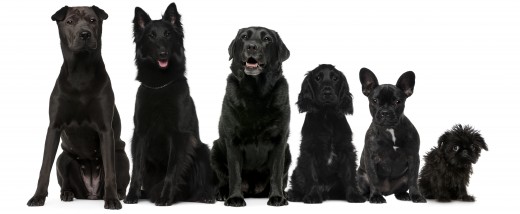There’s nothing I love more than being a myth buster – it’s part of my job, really. I consider it a public service to counteract “Well I heard that…” with “[Authors] concluded that”, and that’s what you’ve gotten yourself in to here. So sit back and get ready to have your mind blown by science!
1 human year = 7 dog years
In a perfect world, we would have a one size fits all to determine how old dogs “actually” are (i.e. how their anatomy and physiology are deteriorating in relation to that of a human). I’ve been told time and time again that this magic ratio is 1:7, which would make Atlas a hot young bachelor with the world at his paw tips (aka age 35). However, according to info from the AVMA when I account for his gargantuan size, he’s probably something closer to mid forties (even though he still tells everyone he’s in his 30’s). In the end, there’s no solid conversion of dog to human years, but once a dog is 6 for large breeds or 7 for smaller dogs, they are considered seniors (don’t tell Atlas).

Old? ME??!?
Eating grass? He’s SICK I tell you!
Some owners will see their dog eating grass and immediately freak out. They think that their dog is on his death bed, but not all grass eating is indicative of a problem (or followed by a revolting dog chuck). Bjone et al (2007) showed that over 709 events of grass eating by dogs, vomiting only occurred 5 times – a strike rate of just 0.7%. Aside from showing it’s not just to induce vomiting, these authors managed to demonstrate just how common a behaviour it is for dogs, concluding that it really shouldn’t be perceived as an issue by worried owners.
Dogs can’t sweat
This is an out and out lie. Yes, it’s not the main mechanism of cooling in dogs, but that doesn’t mean that they a) don’t have sweat glands and b) never sweat. While the exact physiological stimulus for dogs to sweat is still unknown, dogs do have the same type of sweat glands we have in our stinky armpits – they just have them on their paw pads. They’re called atrichial (aka eccrine, aka merocrine) sweat glands and (although anecdotal) have been noted to produce sweat in nervous or excited dogs (Muller & Kirk, 2007). So next time some one tries to tell you dogs pant because they can’t sweat, tell them they are wrong – dogs pant because although they have sweat glands and can sweat, it is more efficient for them to lose heat through evaporative cooling via the airways.

A dogs paw pad hides more than just scales..
Female dogs should have a litter before being desexed
For me, this is the same as saying “Women should have a baby to calm them down/prevent disease/any other stupid reason”. I’ve already had a big rant about desexing and why it’s important in an earlier blog. This myth is a reason that some people think it’s a good idea to hold off on desexing, and I can confirm that it is 1000000% bull shit. Oestrus (aka ‘heat’) and pregnancy are two triggers for dog-dog aggression discussed by Sherman et al (1996), particularly between female dogs. And their solution? DESEX THEM. Retrospective studies have also found no link between a female dog’s reproductive status and human directed aggression (Casey et al, 2014).
All dogs came from domesticated gray wolves
This is a popular one which people often throw out there as trivia. While modern dogs do share a lot of genetic similarity with the gray wolf, they are actually ‘sister’ species rather than ancestor/decedent, as are many other extant wolf species. It’s a rather muddled story in terms of the genetics, because while dogs were becoming a distinct subspecies, they still interbred with wolves, increasing the amount of common DNA between them (Parker & Gilbert, 2015). The current theory is that a now extinct wolf species diverged in two or three directions, creating the genetic basis for both the domestic dog, the gray wolf and also an extinct Siberian wolf (Skoglund et al, 2015) . An important thing to note is that this may or may not have aligned in time with domestication – the modern dog may have been well on the way to becoming a unique subspecies well before any interaction with humans.

Taken directly from Skoglund et al (2015), depicting the relationship between gray wolves, the extinct Siberian wolf and domestic dogs.
Black dogs don’t get adopted 😦
This has gained a lot of momentum through social media, with numerous posts encouraging people to remember the poor forgotten black dogs when searching for a new best friend at a shelter. As far as I can tell, it was originally derived from the anecdotes of shelter workers and has now become a “phenomenon”. Funnily enough, some research has shown the opposite, that colour is not an indicator of either a dog being less likely to be adopted or waiting longer for adoption (Protopopova et al, 2012). Other studies have suggested that while being a black dog means you are adopted 13% less than the most adopted colour, you’re still above red and orange coats. In addition, coat colour in this case was shown to be a pretty poor predictor of adoption behind things like age, breed and size (DeLeeuw, 2010).

Who wouldn’t want a sleek and shiny black dog! Or a sleek and shiny dog of any colour while we’re at it.
We hope we have helped to dispel the myths and encourage you to always try and find solid proof from a reliable source before spouting dog (or any other) facts!
With love,

References
Bjone S.J., Brown W.Y., Price I.R., 2007, Grass eating patterns in the domestic dog, Canis familiaris. Recent Advances in Animal Nutrition in Australia, 16: 45-49
Casey R.A., Loftus B., Bolster C., Richards G.J., Blackwell E.J., 2014, Human directed aggression in domestic dogs (Canis familiaris): Occurrence in different contexts and risk factors. Applied Animal Behaviour Science, 152: 52-63
DeLeeuw J.L., 2010, Animal Shelter Dogs: Factors predicting adoption versus euthanasia. PhD thesis, Wichita State University
Miller W, Muller G, Scott D, Griffin C, Campbell K. Muller & Kirk’s Small Animal Dermatology [e-book]. St. Louis, Mo: Saunders; 2013
Protopopova A., Gilmour A.J., Weiss R.H., Shen J.Y., Lawrence Wynne C.D., 2012, The effects of social training and other factors on adoption success of shelter dogs. Applied Animal Behaviour Science, 142 (1–2): 61-68
Parker H.G. & Gilbert S.F., 2015, From caveman companion to medical innovator: genomic insights into the origin and evolution of domestic dogs. Advances in Genomics and Genetics, 5:239-255
Sherman C.K., Reisner I.R., Taliaferro L.A., Houpt K.A., 1996, Characteristics, treatment, and outcome of 99 cases of aggression between dogs. Applied Animal Behaviour Science, 47 (1–2): 91-108
Skoglund P., Ersmark E., Palkopoulou E., Dalen L., 2015, Ancient wolf genome reveals an early divergence of domestic dog ancestors and admixture into high-latitude breeds. Current Biology, 25: 1515-1519
